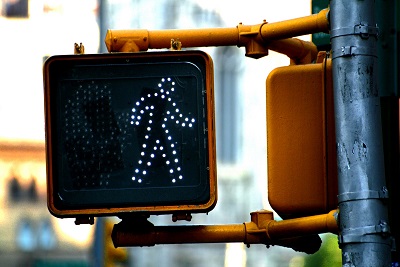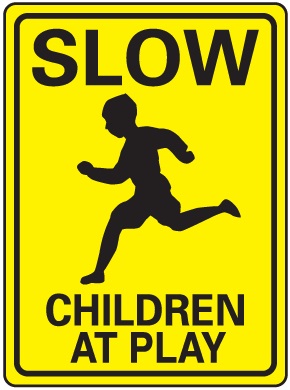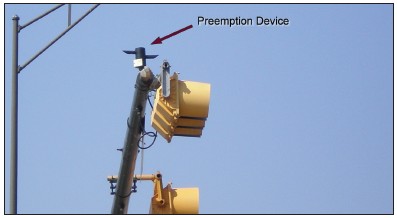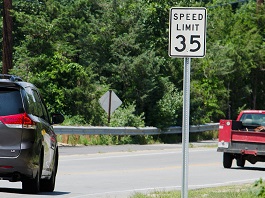- Will the "walk light" for pedestrians remain on until I am safely across the street?
- Do "children at play" signs help protect our children?
- How do I treat a traffic signal during a power outage or a signal that is not working?
- What is an Emergency Preemption System and how does it work?
- Can the posted speed limit on my street be reduced to slow down the speeding drivers?
Will the "walk light" for pedestrians remain on until I am safely across the street?
 A steady, illuminated display of “WALK,” or symbol of a walking person, means you may begin to cross the roadway and proceed in the direction indicated. If there is a push button on the pole, you must first push it to receive a “WALK” signal.
A steady, illuminated display of “WALK,” or symbol of a walking person, means you may begin to cross the roadway and proceed in the direction indicated. If there is a push button on the pole, you must first push it to receive a “WALK” signal.
A flashing “DON’T WALK,” or flashing symbol of an upraised hand, means if you are already in the crosswalk, you have time to finish crossing. If you are still at the curb, do not begin to cross and wait for the next “WALK” signal.
A steadily illuminated “DON’T WALK” display, or symbol of an upraised hand, means that a pedestrian cannot legally enter the roadway as traffic is or will begin moving through the crosswalk.
Do "children at play" signs help protect our children?
 Studies conducted in cities where such signs are widely posted, show no evidence of having reduced pedestrian accidents or vehicular speeds. When "children at play" signs are installed, they give a false sense of security and do not improve safety. Our children should not be encouraged to play in the street. In fact, federal standards reject these types of signs because they openly suggest that playing in the streets is acceptable.
Studies conducted in cities where such signs are widely posted, show no evidence of having reduced pedestrian accidents or vehicular speeds. When "children at play" signs are installed, they give a false sense of security and do not improve safety. Our children should not be encouraged to play in the street. In fact, federal standards reject these types of signs because they openly suggest that playing in the streets is acceptable.
The city posts signs designed specifically for schools and crosswalks that serve a clear and practical purpose, but do not post "children at play" signs as they are not recognized as traffic control devices.
How do I treat a traffic signal during a power outage or a signal that is not working?
 Treat the intersection as an all-way stop. First, come to a full stop, look all directions. If there is neither traffic, nor pedestrians, drive cautiously through the intersection. If there is other traffic, common courtesy requires that the driver who stops first, goes first. If in doubt, you should yield to the driver to your right and continue clock-wise. Be courteous and careful. Never insist on the right of way at the risk of a crash.
Treat the intersection as an all-way stop. First, come to a full stop, look all directions. If there is neither traffic, nor pedestrians, drive cautiously through the intersection. If there is other traffic, common courtesy requires that the driver who stops first, goes first. If in doubt, you should yield to the driver to your right and continue clock-wise. Be courteous and careful. Never insist on the right of way at the risk of a crash.
What is an Emergency Preemption System and how does it work?
 The Emergency Preemption System turns traffic lights at designated intersections “green” for emergency vehicles to navigate Cuyahoga Falls during urgent situations. The system reduces emergency response times and traffic conflicts between the motorists and emergency vehicles, keeping the welfare of our residents a top priority.
The Emergency Preemption System turns traffic lights at designated intersections “green” for emergency vehicles to navigate Cuyahoga Falls during urgent situations. The system reduces emergency response times and traffic conflicts between the motorists and emergency vehicles, keeping the welfare of our residents a top priority.
Can the posted speed limit on my street be reduced to slow down the speeding drivers?
 In order to determine speed limits, traffic engineering studies are conducted which analyze the prevailing speed of most drivers traversing the street in question. Additionally, the studies take into account accident records and road conditions. An appropriate speed limit is then set based upon this data and is backed up by police patrols and speed enforcement stops. If you feel that drivers are abusing the limit in your neighborhood, please take advantage of our Speed Limit Observation Program.
In order to determine speed limits, traffic engineering studies are conducted which analyze the prevailing speed of most drivers traversing the street in question. Additionally, the studies take into account accident records and road conditions. An appropriate speed limit is then set based upon this data and is backed up by police patrols and speed enforcement stops. If you feel that drivers are abusing the limit in your neighborhood, please take advantage of our Speed Limit Observation Program.
